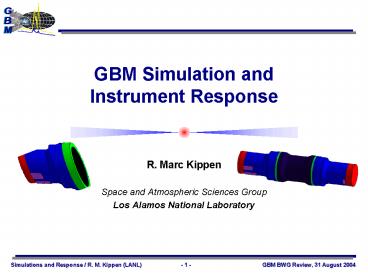GBM Simulation and Instrument Response PowerPoint PPT Presentation
1 / 16
Title: GBM Simulation and Instrument Response
1
GBM Simulation and Instrument Response
- R. Marc Kippen
- Space and Atmospheric Sciences Group
- Los Alamos National Laboratory
2
GBM Detector / Instrument Response
GRB Photon Spectrum
Instrument Response
Instrument Background
Observed Data
3
Simulation and Detector Response Software
- Definition Multi-purpose software suite that
computes the physical and instrumental response
of the GBM instrument system - Primary purpose generate detector response
functions critical to the analysis of flight
science data - Other uses instrument design interpretation of
calibrations design of flight and ground
analysis algorithms s/w - Technique Numerical simulation Monte Carlo
radiation transport - Verified through, and incorporating results from
experimental calibration
- Major Components
- Mass model (geometry composition)
- Incident particle distributions
- Radiation transport physics
- Instrumental/calibration effects
- DRM database
- DRM synthesizer/generator
4
Key Functional Specifications
- GBM SIM/DRM S/W Functional Specs
- GBM-SPEC-1025 (reviewed at GSW PDR)
- GBM IODA S/W Functional Specs
- GBM-SPEC-1031 (reviewed at GSW PDR)
- Complete and accurate interaction physics
(included in core simulation package GEANT4) - Accurate mass models, environment models, and
instrument models (but not overly complex) - Later stages of development require S/C models
(including LAT model)
- Verification through comparison with experimental
data - Final DRMs must include contribution from
atmospheric scattering (direct detector and S/C
scattered response) - GLAST S/C will have rapid slew capability
different DRMs are required whenever aspect
changes by gt 1 - DRM generation s/w is part of GBM IODA s/w and
subject to the same requirements for standards,
configuration control, etc.
5
Development Organization
- SIM/DRM software designed and developed at LANL
in collaboration with GBM PI and GSW lead - Development process falls under GSW Development
Plan (GBM-PLAN-1023) - Final products (s/w and data) delivered to GBM PI
at NSSTC (also available to MPE and other
interested parties)
6
Phased Software/Model Development
- Software and models require cross-validation with
calibration data - Three phases of SIM/DRM sw/model development
- Design
- Simulate prototype detectors
- Calibration
- Simulate three levels of calibration/test
- Detector level
- GBM system level
- On-spacecraft level
- Operation
- In-flight configuration appropriate for analysis
of science data - DRM generation
7
Implementation GBM REsponse Simulation System
- Integrated package that will encompass all GBM
instrument response software and data needs - Configuration controlled as a single deliverable
package with component software/data modules - All packages (and their dependencies) use GNU
compilers mainly g - All data files have headers with detailed version
job tracking data - Final phase package will be a subset of the GBM
IODA software, cf. GBM-SPEC-1036 (GSW Arch.
Design)
GRESS
gbmsim GBM instrument physical simulator
calsim Instrumental/calibration effects data
packager
atmosim Atmospheric scattering simulator
arpack Atmospheric scattering data packager
drmgen Application-specific DRM generator
8
Implementation GBM REsponse Simulation System
GRESS/IODA Overlap Area
GRESS
IODA
Cal. Params.
Cmds.
Mass model
Data Analysis Software (IOC)
drmdb
root files
gbmsim
calsim
Cmds.
drmgen
Aux. data
Application Specific DRM
Spectrum or DRM
caldb
atmosim
armdb
root files
arpack
Source Location Software (SSC IOC)
Cmds.
Mass model
Spectrum or ARM
Note a separate, reduced DRM/ARM database is
used for BAP software (based on same simulation
data)
9
How Direct Instrument Response
gbmsim Raw physical data
calsim Packaged, instrument-like data
10
How Atmospheric Scattered Response
atmosim Raw physical data
arpack Packaged data matrix
NRLMSISE-2000 atmospheric model used to create
concentric shell mass model
11
How Putting it all Together
drmgen burst-specific response generator
Data Analysis spectral fitting and localization
12
How Response used for Spectral Analysis
rmfit/xspec spectral model hypothesis testing
Model GRB Spectrum
Total Det. Response
Background Model
Observed/Predicted Counts
iterate
- Parameterized spectral models
- Built-in models or custom models
- From drmgen
- Updated automatically when S/C pointing changes
- Empirical, time-dependent model based on data
before and after burst
- Observed and predicted counts compared via test
statistic - Chi-squared (Gaussian) or Poisson log Likelihood
- Optimize test Stat. iteratively
Process is extended to simultaneously include
multiple GBM detectors (Incl. NaI and BGO) or
other instruments (e.g., LAT, Swift, etc.)
13
How Response used for Localization
Simultaneous spatial/spectral model hypothesis
testing
Internal response generator
Predicted detector counts
Chi-square evaluation
Trial Spectral Parameters
Observed Det. counts
Spatial/spectral optimization
S/C attitude/ position
Background model
caldb
14
Development Status
- SIM/DRM development is affected by
- Delivery of GBM detector design data/drawings
(received June 2004, three months behind original
schedule) - Delivery of GLAST spacecraft design data/drawings
(expected July 2004, three months behind original
schedule, initial delivery August 2004) - Schedule of GBM calibrations
- Required to verify SIM/DRM s/w and models
- Detector level (MPE), system level (NSSTC),
spacecraft level (Spectrum) all slipped due to
launch slip. - Development status
- Preliminary versions of GRESS software complete
(several months ahead of schedule) - Detector model development nearing completion (3
months behind) - Spacecraft model development starting (3 months
behind) - Result able to meet required delivery schedule
15
SIM/DRM Revised Delivery Schedule
Stable since GBM System CDR June 2004
- All deliveries from LANL to NSSTC
- Schedule changes from ground s/w CDR reflect
changes in - the GBM calibration schedule (affected by launch
slip)
16
SIM/DRM Schedule

